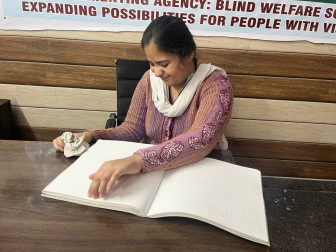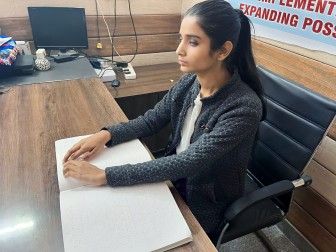In today’s increasingly digital and interconnected world, assistive technology plays a pivotal role in shaping workplace success for the visually impaired. These innovative tools and technologies enable individuals with visual impairments to perform tasks efficiently, communicate effectively, and contribute fully to their roles. By leveraging assistive technology, visually impaired professionals can overcome barriers, achieve their career goals, and excel in their chosen fields.
Assistive technology encompasses a wide range of devices and software designed to support individuals with disabilities in their daily activities. For the visually impaired, this technology includes tools that aid in navigation, communication, and interaction with digital content. The integration of these tools into the workplace can significantly enhance productivity, independence, and job satisfaction.
1. Screen Readers and Text-to-Speech Software:
Screen readers like JAWS (Job Access With Speech) and NVDA (NonVisual Desktop Access) are essential tools that convert on-screen text into spoken words. These programs enable visually impaired employees to access digital documents, emails, and web content with ease. Text-to-speech software, such as Kurzweil 3000, also provides similar functionality, allowing users to listen to written content and interact with digital media efficiently.
2. Braille Displays and Notetakers:
Braille displays and notetakers are valuable tools for those who read Braille. Devices like the BrailleNote Touch and BrailleSense Polaris provide a tactile interface for reading and inputting text. These devices can connect to computers and smartphones, allowing users to access and create documents, manage emails, and navigate applications using Braille.
3. Optical Character Recognition (OCR) Technology:
OCR technology, such as the KNFB Reader and Seeing AI, converts printed text into digital format, which can then be read aloud by screen readers or displayed on Braille devices. This technology is particularly useful for scanning and interpreting physical documents, making it easier to handle reports, letters, and other written materials in the workplace.
4. Voice-Controlled Assistants:
Voice-controlled assistants like Amazon Alexa, Google Assistant, and Apple's Siri offer hands-free interaction with technology. These assistants can perform tasks such as setting reminders, managing calendars, and providing information on demand. For visually impaired employees, these voice assistants can streamline daily tasks and enhance productivity.
5. Navigation and Orientation Tools:
Smart navigation aids, such as the WeWALK smart cane and Aira’s visual interpreting service, help visually impaired individuals navigate their environment more effectively. These tools provide real-time feedback on obstacles, directions, and points of interest, making it easier to navigate both indoor and outdoor spaces within the workplace.
1. Customized Solutions:
Employers should work with visually impaired employees to identify the most suitable assistive technologies for their specific needs. Customizing solutions ensures that the technology aligns with the employee’s role and enhances their ability to perform job tasks effectively.
2. Training and Support:
Providing training on how to use assistive technology is crucial for maximizing its benefits. Employers should offer training sessions and ongoing support to help employees become proficient with their tools. This can include workshops, one-on-one coaching, and access to technical support.
3. Inclusive Design and Accessibility:
Incorporating inclusive design principles and ensuring that digital content and workplace systems are accessible can further enhance the effectiveness of assistive technology. Employers should consider accessibility features when developing internal systems, software, and communication platforms.
4. Encouraging Open Communication:
Creating an open and supportive environment where employees feel comfortable discussing their assistive technology needs can foster a more inclusive workplace. Encouraging dialogue helps identify potential barriers and ensures that employees have the resources they need to succeed.
Assistive technology empowers visually impaired individuals to achieve their full potential in the workplace. By facilitating access to information, improving communication, and enhancing productivity, these tools enable employees to perform at their best and contribute meaningfully to their teams.
The integration of assistive technology also promotes inclusivity and diversity within organizations. It demonstrates a commitment to providing equal opportunities and supporting employees with disabilities, fostering a more inclusive and equitable work environment.
The future of assistive technology holds exciting possibilities, with advancements in artificial intelligence, machine learning, and wearable technology paving the way for even greater innovations. Emerging technologies, such as AI-driven real-time captioning and advanced haptic feedback devices, have the potential to further enhance accessibility and workplace success for the visually impaired.
Leveraging assistive technology is key to achieving workplace success for the visually impaired. By utilizing tools such as screen readers, Braille displays, OCR technology, and voice-controlled assistants, individuals with visual impairments can overcome barriers and excel in their careers. Implementing customized solutions, providing training and support, and fostering an inclusive environment are essential for maximizing the benefits of assistive technology. As technology continues to evolve, the potential for greater accessibility and empowerment in the workplace remains promising, paving the way for a more inclusive and equitable future.
By contributing to our feature donation campaigns, you are not just supporting us,
you are fostering independence, education, and accessibility for the people with blindness.
We are providing free shelter, food and educational support to the abandoned visually impaired girls residing at BWS.
₹1105795
raised of ₹2000000 Goal
55%
4 Days left
554 Supporters
Maa and Papa weren’t the happiest when I was born. They thought I was a burden to them.
₹666390
raised of ₹2000000 Goal
33%
4 Days left
499 Supporters
The Walking Canes have proved a useful tool to millions of blind people in navigating their environments with confidence and ease.
At our organization, we provide a nurturing environment for visually impaired girls, helping them lead fulfilling lives despite their challenges.
The following stories highlight the transformative journey of these remarkable individuals within our organization.

Hailing from Delhi, Sneha came to Blind Welfare Society in July 2023.
.jpeg)
Hailing from a small village of Gwalior district, Madhya Pradesh, Archana came to Blind Welfare Society in July 2023

Chhavi’s journey is a testament to the transformative power of education and the invaluable support provided by the Blind Welfare Society.